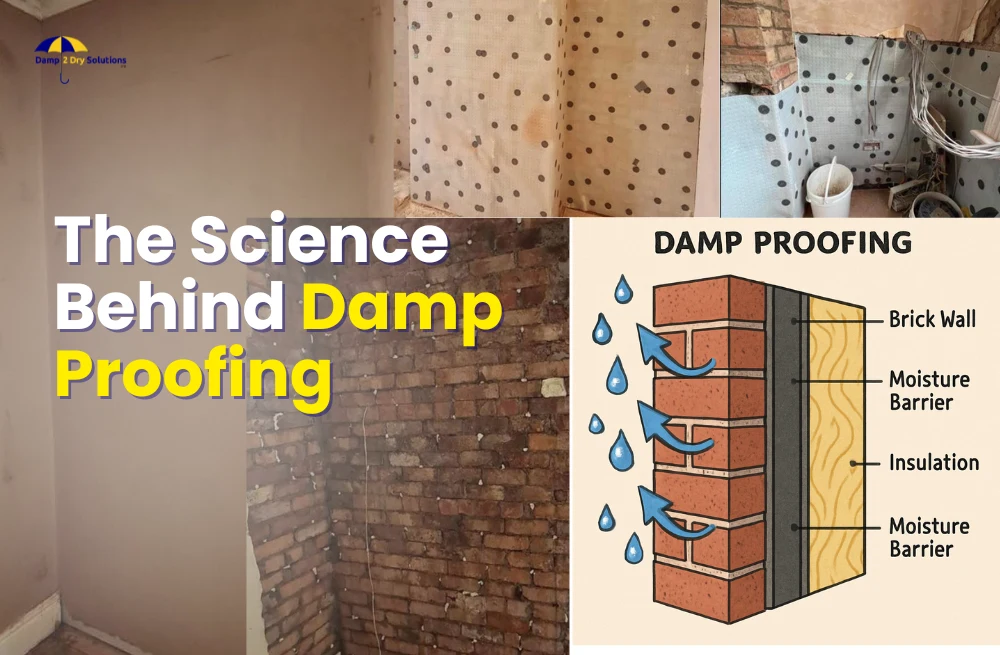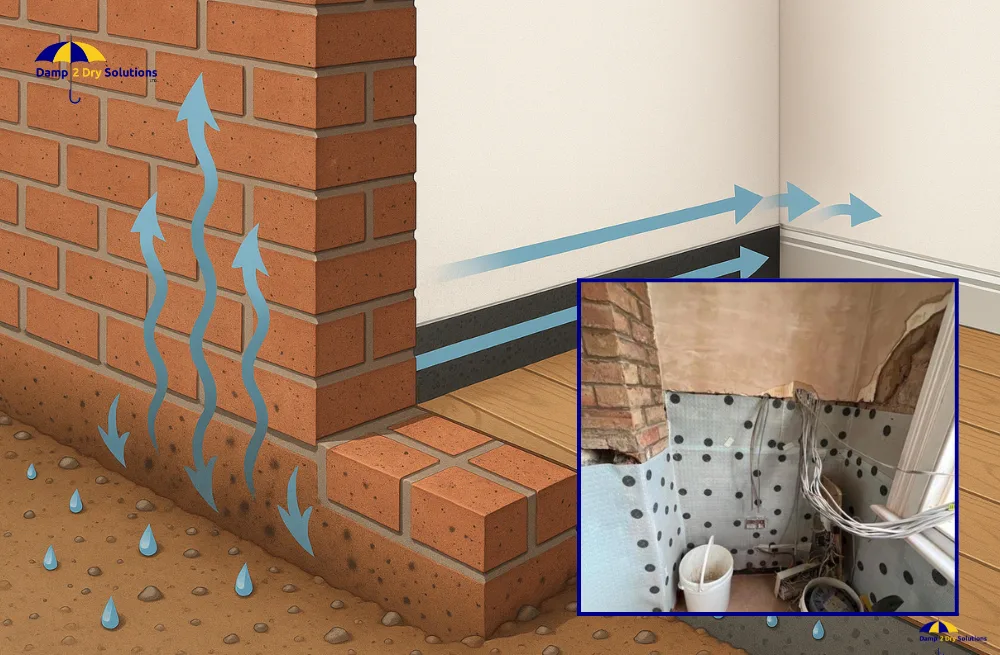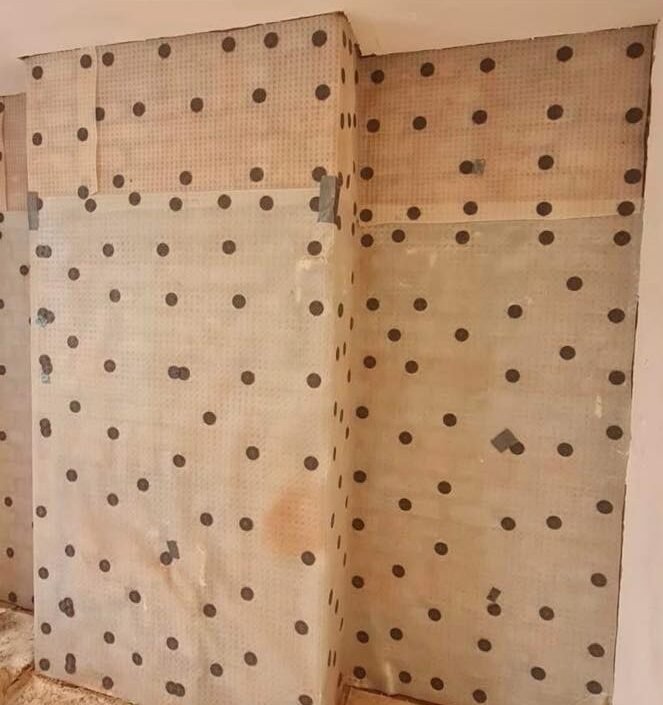
What Is Damp and Why Should You Care?
Let’s be honest, damp is one of those home issues we all dread but often ignore until it starts peeling paint or making the whole house smell like a forgotten cellar. It’s sneaky. It doesn’t kick your door down. It seeps, slowly and silently, into your walls, floors, and ceilings, quietly doing damage in the background.
At its core, damp just means too much moisture in places it’s not supposed to be. That might be water creeping up through brickwork, rain finding its way through worn-out pointing, or steam from your shower clinging to cold windows. Rising damp, penetrating damp, and condensation, they all behave differently, but none of them are good news for your home.
And once damp sets in? Well, let’s just say your plaster, wallpaper, and timber won’t thank you for it. That’s why damp proofing exists, not as a fancy upsell, but as an essential line of defence against moisture’s many tricks.
So, How Does Damp Proofing Actually Work?
You might think of damp proofing as just painting something over the problem. Not quite. It’s a bit smarter than that.
At its heart, damp proofing is about stopping moisture at the source or redirecting it in a way that it doesn’t cause damage. The solution depends on where the moisture’s coming from. Is it rising from the ground? Blowing in from outside? Forming inside because the air’s too wet and there’s nowhere for it to escape?
Take rising damp, for instance, that’s water moving up through bricks from the soil below, like tea climbing up a sugar cube. Here, we’re talking about breaking that capillary action with a damp-proof course — often a chemical one that’s injected into the wall. Once it sets, it acts as a barrier that tells the moisture: “You’re not welcome past this point.”
But if the problem’s outside, let’s say rain seeping through a dodgy patch of brickwork, you’ll need to think more about physical barriers. That might be membrane layers, waterproof coatings, or just a good bit of repointing work.
Then there’s condensation, the most common but often the most misunderstood. You breathe, cook, bathe — all of that adds water to the air. Without decent airflow or insulation, that vapour hits a cold wall or window and turns back into water. Damp proofing here isn’t about blocking water; it’s about managing the environment — think ventilation, insulation upgrades, or systems like PIV units that improve air circulation.
Moisture Doesn’t Just Appear — It Moves

Here’s where things get a bit nerdy, but stick with me. Understanding how moisture travels helps make sense of why certain solutions work (and why others don’t).
In older houses especially, bricks act like sponges. Without a proper damp-proof course, they soak up groundwater and pull it upwards — a phenomenon known as capillary action. Imagine dipping the corner of a napkin into a cup of water and watching the liquid climb up. Same idea, just swap napkin for brickwork.
Another one to watch out for is hydrostatic pressure. If your basement walls are holding back soggy earth after a downpour, that pressure can push moisture straight through unless the walls are sealed properly. That’s why basement tanking exists — not just to coat the walls but to resist that constant external push.
And finally, there’s thermal bridging. If your home has spots that are colder than others (common in poorly insulated properties), warm moist air will find them and condense into water droplets. It’s the reason you might see mould patches in corners or behind furniture, cupboards — the air’s damp and those cold areas are magnets for condensation.
Damp Proofing in Real Life (Not the Brochure Version)

Let’s talk about the actual tools in the damp proofer’s toolkit — and why they work.
Chemical DPCs are the go-to for rising damp. Tiny holes are drilled into the base of your walls, then filled with a water-repellent solution. It soaks into the brickwork and cures into a barrier. Think of it as giving your house waterproof socks.
Damp-proof membranes are more hands-on — actual sheets or layers that physically block water from passing through. These might go under floors, behind plaster, or against foundations. They’re particularly useful when you know moisture is coming from a specific direction and you want to shut the door on it.
Tanking is big in basements. This involves slapping a waterproof slurry onto the walls, effectively sealing them from the inside. Once cured, it’s tough stuff — it can hold back groundwater under pressure and turn a damp cellar into a usable, dry space.
Then there are systems like Positive Input Ventilation (PIV). These are clever bits of kit that draw in fresh air from the loft and gently push it through the house. The idea is to keep humidity levels in check, so condensation has less chance to form.
Lastly, if you’ve got cavity wall insulation that’s become damp or was badly installed (a common culprit for damp in homes retrofitted in the 90s and 2000s), removing it is often the best option. Trapped wet insulation can’t breathe and just makes your damp problem worse.
Also Read: Top 7 Damp Proofing Solutions You Can Apply
Why Those Quick Fixes Rarely Work
It’s tempting to reach for a tub of anti-mould paint or plug in a dehumidifier and hope the problem goes away. We’ve all been there.
But damp is like a leak under a carpet — you can cover it up, but it’s still there. If you only treat the visible symptoms, the real issue just keeps growing behind the scenes. Paint peels, mould returns, timber warps — and suddenly you’re in deeper than before.
That’s why getting a proper survey is worth every penny. A trained damp specialist won’t just point at a patch and call it mould. They’ll check moisture levels, probe inside walls, assess air flow, and figure out why your home is damp — not just where.
Will Damp Proofing Last Forever?
Short answer? If done properly, it’ll last a long time — sometimes decades. But like anything else in your home, it needs maintenance.
Chemical DPCs can break down if the walls are constantly wet or poorly ventilated. Membranes only work if they’re undamaged and properly installed. Even the best ventilation system won’t help if your gutters are overflowing and soaking the wall from outside.
In other words: damp proofing is part of a bigger picture. Think of it as the foundation of a healthy home, but one that still needs regular care.
Final Thoughts
Damp proofing probably isn’t the most exciting part of home ownership — no one brags about their chemical DPC on Instagram. But it’s one of the smartest long-term investments you can make.
It’s not just about protecting your house from mould or ugly stains. It’s about safeguarding your health, keeping your heating bills down, and preserving the value of your property.
Understanding the science behind it isn’t just for surveyors. It gives you the knowledge to spot warning signs early, to ask the right questions, and to avoid wasting money on surface-level fixes.
Because at the end of the day, your home shouldn’t just look dry. It should be dry — and stay that way. Explore our expert damp proofing and cavity wall insulation removal services across Manchester, Cheshire, and the North.
Ready to get started? Click the button below to book your inspection today.

Pingback: Complete Damp Proofing Guide for Long-Lasting Home Safety